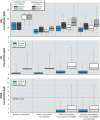Pollutant exposures from natural gas cooking burners: a simulation-based assessment for Southern California
- PMID: 24192135
- PMCID: PMC3888569
- DOI: 10.1289/ehp.1306673
Pollutant exposures from natural gas cooking burners: a simulation-based assessment for Southern California
Abstract
Background: Residential natural gas cooking burners (NGCBs) can emit substantial quantities of pollutants, and they are typically used without venting range hoods.
Objective: We quantified pollutant concentrations and occupant exposures resulting from NGCB use in California homes.
Methods: A mass-balance model was applied to estimate time-dependent pollutant concentrations throughout homes in Southern California and the exposure concentrations experienced by individual occupants. We estimated nitrogen dioxide (NO2), carbon monoxide (CO), and formaldehyde (HCHO) concentrations for 1 week each in summer and winter for a representative sample of Southern California homes. The model simulated pollutant emissions from NGCBs as well as NO2 and CO entry from outdoors, dilution throughout the home, and removal by ventilation and deposition. Residence characteristics and outdoor concentrations of NO2 and CO were obtained from available databases. We inferred ventilation rates, occupancy patterns, and burner use from household characteristics. We also explored proximity to the burner(s) and the benefits of using venting range hoods. Replicate model executions using independently generated sets of stochastic variable values yielded estimated pollutant concentration distributions with geometric means varying by <10%.
Results: The simulation model estimated that-in homes using NGCBs without coincident use of venting range hoods-62%, 9%, and 53% of occupants are routinely exposed to NO2, CO, and HCHO levels that exceed acute health-based standards and guidelines. NGCB use increased the sample median of the highest simulated 1-hr indoor concentrations by 100, 3,000, and 20 ppb for NO2, CO, and HCHO, respectively.
Conclusions: Reducing pollutant exposures from NGCBs should be a public health priority. Simulation results suggest that regular use of even moderately effective venting range hoods would dramatically reduce the percentage of homes in which concentrations exceed health-based standards.
Conflict of interest statement
The authors declare they have no actual or potential competing financial interests.
Figures



Comment in
-
Cooking up indoor air pollution: emissions from natural gas stoves.Environ Health Perspect. 2014 Jan;122(1):A27. doi: 10.1289/ehp.122-A27. Environ Health Perspect. 2014. PMID: 24380970 Free PMC article. No abstract available.
References
-
- Akland GG, Hartwell TD, Johnson TR, Whitmore RW. Measuring human exposure to carbon monoxide in Washington, D.C., and Denver, Colorado, during the winter of 1982–1983. Environ Sci Technol. 1985;19:911–918.
-
- Berwick M, Leaderer BP, Stolwijk JA, Zagraniski RT. Lower respiratory symptoms in children exposed to nitrogen dioxide from unvented combustion sources. Environ Int. 1989;15:369–373.
-
- CARB (California Air Resources Board). CA Ambient Air Quality Standards (CAAQS). 2010. Available: http://www.arb.ca.gov/research/aaqs/aaqs2.pdf [accessed 7 October 2013]
-
- CEC (California Energy Commission). California Statewide Residential Appliance Saturation Study. Final Report. 400-04-009. 2004. Available: http://www.energy.ca.gov/reports/400-04-009/2004-08-17_400-04-009ALL.PDF [accessed 27 November 2013]
-
- Delp WW, Singer BC. Performance assessment of U.S. residential cooking exhaust hoods. Environ Sci Technol. 2012;46:6167–6173. - PubMed
Publication types
MeSH terms
Substances
LinkOut - more resources
Full Text Sources
Other Literature Sources

